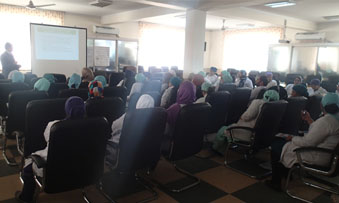Diagnosis and Management of Cerebral Venous Thrombosis
December 30, 2014
View Gallery

Dr Esmatullah facilitating the queries of participants
The French Medical Institute for Children held a continued medical education session on Cerebral Venous Sinus Thrombosis a rare illness affecting about one in a million people annually worldwide. Infants during the first month of life are at the greatest risk of developing the condition where blood clots form in the brain preventing blood from exiting the brain resulting in a stroke.
While conducting the session at the Malalai Maternity Hospital, Dr Esmatullah Hamed Consultant Neurologist and Head of Neurophysiology Services at the French Medical Institute for Children (FMIC) said that three out of 300,000 children were affected by the condition annually.
The session which was conducted on December 30, 2014 at the Malalai Maternity Hospital was a part of FMIC’s efforts to improve working knowledge of healthcare providers especially doctors in Afghanistan. More than 60 doctors and healthcare providers from Malalai hospital attended the session.
The presentation was followed by a thirty-minute question and answer session on the topic. The medical director of Malalai Maternity Hospital, Dr Afiza Omarkhil, expressed her appreciation and observed that such sessions are not only important in building capacity, but also help in strengthening relationships and opening ways for collaboration between FMIC and Malali Maternity Hospital.
FMIC is regarded as Afghanistan’s premier health care facility and the first-ever ISO certified health care institution in the country. The hospital provides modern diagnostics, medical and surgical services and offers inpatient and outpatient services in major fields such as paediatrics, medicine, surgery, cardiology and orthopaedics. Training and capacity building is one of the main objectives of the hospital. FMIC has its own Postgraduate Medical Education Programme in seven disciplines, to build the human resource capacity for Afghanistan’s future needs. A new wing comprising 66 beds for obstetrics, gynaecology and neonatology is also under development.